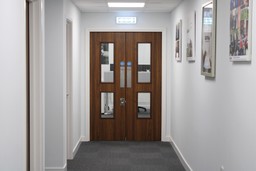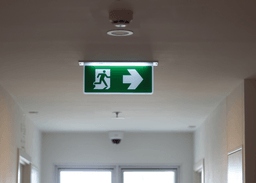Fire Safety in Commercial Buildings: What You Need to Know
Fire safety in commercial buildings is a critical responsibility for owners, tenants, and managers. It ensures not only compliance with legal requirements but also the protection of lives and assets. At Gerda Security, we specialise in fire safety solutions tailored to meet the latest regulations, providing peace of mind for property stakeholders. This guide covers… Continue reading Fire Safety in Commercial Buildings: What You Need to Know
Fire safety in commercial buildings is a critical responsibility for owners, tenants, and managers. It ensures not only compliance with legal requirements but also the protection of lives and assets. At Gerda Security, we specialise in fire safety solutions tailored to meet the latest regulations, providing peace of mind for property stakeholders. This guide covers everything you need to know about fire safety regulations, practical measures you’ll need to take, and expert recommendations for ensuring your building is protected.
Key Takeaways
- Fire safety regulations commercial buildings must follow include the Fire Safety (England) Regulations 2022, and BS EN 1634 for fire resistance and smoke control.
- Fire doorsets are vital for containing fires and protecting escape routes.
- Regular inspections and maintenance are legally required.
- Non-compliance can result in severe legal and financial consequences.
Why Fire Safety in Commercial Buildings Matters
Fires in commercial buildings can escalate rapidly, endangering lives and causing irreparable property damage. As a result, high-occupancy structures such as office complexes, shopping malls, and industrial facilities must adopt robust fire safety strategies. Effective fire safety measures save lives, reduce injuries, and minimise economic loss.
The best fire safety systems are ‘proactive’ too, ensuring risks are identified and mitigated before incidents occur.
Fire Safety Regulations for Commercial Buildings
The fire safety regulations commercial buildings must adhere to were updated in October 2023. These regulations outline mandatory measures designed to enhance safety and prevent disasters.
Key Requirements:
- Fire Risk Assessments: All commercial buildings must conduct and maintain written fire risk assessments. These evaluations help to identify both hazards, and the mitigation measures needed to deal with them.
- Fire Detection Systems: Smoke detectors, alarms, and heat sensors must be installed in key areas, and inspected regularly.
- Emergency Lighting: Backup lighting is mandatory along escape routes, in order to guide occupants to an exit during power failures.
- Fire Doorsets: Fire doorsets must meet regulatory standards, providing fire resistance and ensuring escape routes remain accessible.
To learn more about how we can help, read how Gerda Security supports commercial fire safety measures.
Fire Risk Assessments: The Foundation of Fire Safety
A fire risk assessment (FRA) is a cornerstone of fire safety in commercial buildings. Conducted by a responsible person, it identifies fire hazards, evaluates risks, and suggests preventive measures.
How to Conduct an FRA:
- Identify potential fire sources (e.g., electrical systems, flammable materials).
- Determine who may be at risk, including staff, visitors, and vulnerable individuals.
- Evaluate existing safety measures, such as alarms and fire doorsets.
- Implement new measures where needed.
- Schedule regular reviews and updates.
Review your FRA annually or after significant changes, such as renovations or increased occupancy.
The Vital Role of Fire Doorsets in Fire Safety
Fire doorsets are essential for containing fires and smoke, giving occupants more time to evacuate and reducing property damage. They play a crucial role in escape route safety, ensuring pathways remain clear and functional.
Benefits of Fire Doorsets:
- Containment: Prevent the spread of fire and smoke.
- Escape: Ensure safe passage for occupants.
- Compliance: Meet strict fire safety regulations.
At Gerda Security, our fire doorsets are rigorously tested and designed for longevity, ensuring they not only meet, but exceed current safety standards.
Emergency Lighting and Fire Safety Signage
During a fire, visibility is critical. As mentioned earlier, emergency lighting ensures that occupants can navigate escape routes even during power outages, and these systems must be installed in stairwells, hallways, and key areas like building exits.
Emergency Lighting isn’t the only safety measure to be taken, however. In addition, proper signage helps occupants understand evacuation procedures and locate fire safety equipment. Common signs include:
- Fire exit markers.
- Fire extinguisher ID signs.
- Assembly point indicators.
Remember to test emergency lights monthly and replace bulbs promptly to avoid failure during emergencies.
Detection Systems and Regular Maintenance
Reliable fire detection systems are the first alert in the event of a fire. These include smoke detectors, heat sensors, and integrated alarm systems. Regular testing and maintenance are legally required to ensure optimal performance.
Basic Maintenance Checklist:
- Test alarms weekly.
- Inspect smoke detectors bi-annually.
- Replace batteries as needed.
- Schedule professional inspections annually.
The Costs of Non-Compliance
Failure to meet fire safety regulations in commercial buildings can have severe consequences, including:
- Large fines,
- Closure of the premises,
- Legal action or imprisonment for extreme negligence.
Investing in compliance not only protects lives but also shields businesses from financial and reputational harm.
Partner with Fire Safety Experts
Ensuring compliance with fire safety regulations can be complex, but partnering with specialists like Gerda Security simplifies the process. From advanced fire doorsets to wayfinding signage and maintenance services, we help commercial buildings stay safe and compliant.
Learn more about our solutions for commercial buildings.
Frequently Asked Questions
What is the purpose of a fire risk assessment?
A fire risk assessment identifies fire hazards, evaluates risks, and recommends measures to enhance safety in commercial buildings.
How often should fire doorsets be inspected?
Fire doorsets should be inspected every six months and maintained regularly to ensure compliance and functionality.
Who is responsible for fire safety in a rented commercial property?
Tenants are usually responsible for their leased areas, while landlords handle common spaces.
What happens if I fail to comply with fire safety regulations?
Non-compliance can result in fines, legal penalties, or imprisonment, depending on the severity of the breach.



